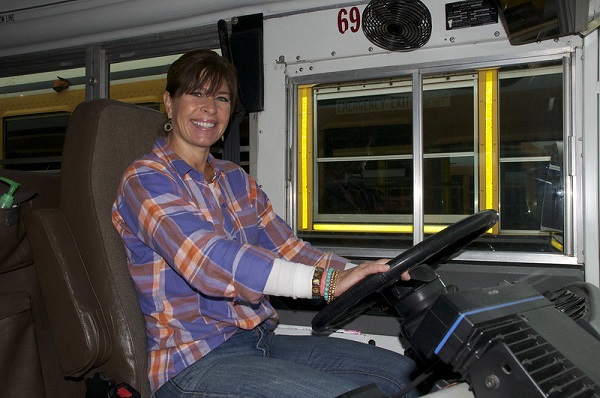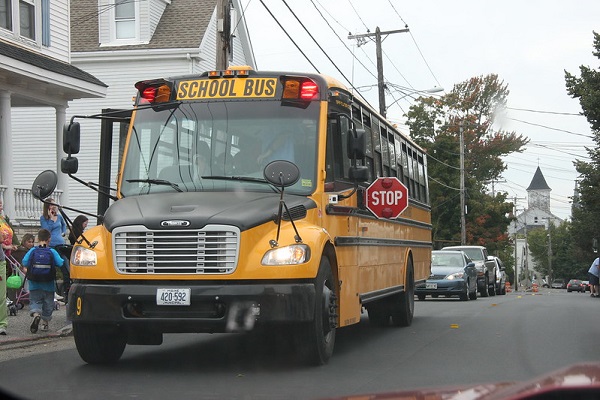
Image Credit: Tom Britt / flickr
Think back to your first day of school. Full of excited nervous energy, unsure of what the year will hold, you race to your bus stop. The first school employee you, see? Your bus driver. A friendly face who will greet you each morning, safely getting you from your house to school every day!
Bus drivers are an essential part of any school district. They enable students to access education by providing transportation to and from school. However, their most important responsibility is ensuring student safety. This includes ensuring a safe ride to school, as well as ensuring that students remain seated safely, and addressing any health emergencies that may arise on the bus. To be able to fulfill these responsibilities, bus drivers must receive proper training in a variety of areas, including customer service, vehicle inspections, and other necessary skills. Without bus drivers, many students would be unable to get to school, making them a crucial part of making education accessible and equitable.

Image Credit: Brian Snelson / flickr
What are the everyday roles of bus drivers?
The daily responsibilities of bus drivers may vary, but they generally include the following tasks:
- Transporting students to and from school
- Ensuring a safe and welcoming environment on the bus
- Planning and following routes to students' homes
- Keeping the bus clean and well-maintained
- Conducting inspections and performing necessary maintenance
- Communicating with students and building positive relationships
One of the primary responsibilities of bus drivers is transporting students to and from school. To do this safely, bus drivers must obtain a Commercial Driver's License (CDL) with a bus endorsement. This requirement varies by state and can be obtained through the Department of Motor Vehicles (DMV).
Before beginning their routes, bus drivers must also conduct a pre-route checklist to ensure that the bus is in good working condition and there are no mechanical issues. This includes checking the fuel level and examining the bus for any potential problems. Bus drivers should also be trained to spot major issues and identify areas where further issues may arise. This helps to ensure the safety and reliability of the bus during student transportation.
Customer service skills are often overlooked as important for bus drivers, but they are a critical part of the job. Maintaining a safe and welcoming environment on the bus is essential, and strong customer service skills can help bus drivers accomplish this. In addition, good communication and relationship-building skills can help bus drivers connect with students and create a positive atmosphere on the bus. These skills can be developed and improved over time, allowing bus drivers to be as effective as possible in their roles.
Ensuring student safety on the bus is a top priority for bus drivers. One important aspect of this is ensuring that students remain seated in a safe manner while the bus is in motion. Bus drivers must also be prepared for worst-case scenarios and take steps to ensure that students are protected in case of an emergency. To maintain a safe environment on the bus, bus drivers may also set and enforce safety rules, such as prohibiting physical altercations and harassment, and reminding students not to leave their belongings on the bus. By taking these measures, bus drivers can help create a safe and secure environment for students while they are on the bus.
Maintaining a clean and hygienic environment on the bus is also an important responsibility for bus drivers. This includes removing any debris or bodily fluids that may be left behind by students, as well as ensuring that the bus is free of trash. Accidents may occur on the bus, especially when transporting younger students, so it is important for bus drivers to have open and positive communication with their passengers. By building relationships and creating a welcoming atmosphere, students are more likely to feel comfortable approaching the driver with any issues or concerns. In this way, bus drivers can help ensure the safety and well-being of their passengers.
What professional skills do school bus drivers need?
- Safe driving skills: Bus drivers must be able to operate a vehicle safely and effectively, following all traffic laws and regulations.
- Customer service skills: Bus drivers may interact with students, parents, and school staff, so it is important that they have good customer service skills. This includes being friendly, patient, and understanding.
- Communication skills: Bus drivers need to be able to communicate effectively with students, parents, and school staff. This may involve giving instructions, answering questions, or addressing concerns.
- Problem-solving skills: Bus drivers may encounter unexpected situations, such as a student who is behaving poorly or a traffic issue. It is important that they can think on their feet and come up with solutions to problems.
- Time management skills: Bus drivers need to be able to manage their time effectively to pick up and drop off students on schedule.
- Attention to detail: Bus drivers need to pay attention to details, such as the number of students on the bus and their safety while they are on board.
- Physical fitness: Bus drivers need to be physically fit to perform their duties, such as climbing in and out of the bus and assisting students with special needs.
Physical Requirements
There are some physical requirements that all bus drivers must possess to safely perform their duties. These requirements are related to the physical demands of driving a bus for multiple hours per day.
Some of these requirements include:
- Ability to sit for long periods of time: Bus drivers must be able to sit for multiple hours per day to drive the bus.
- Good hand-eye coordination: Bus drivers need good hand-eye coordination to control the bus and respond to traffic and other hazards on the road.
- Strong vision: Bus drivers must have good vision to see the road clearly and identify potential hazards or dangers.
- Good hearing: Bus drivers need good hearing to hear traffic, other vehicles, and other potential hazards on the road.
These physical requirements help bus drivers identify safety concerns and potential incidents before they occur, allowing them to take preventive measures to ensure the safety of the students and other passengers on the bus.
Interpersonal Communication
Interpersonal skills are an important aspect of being a successful bus driver. Bus drivers interact with students, parents, and school staff on a regular basis, and the way they communicate and interact with others can greatly impact their ability to do their job effectively.
One key aspect of interpersonal skills for bus drivers is the ability to communicate effectively with students. Bus drivers should be welcoming and friendly to students and try to get to know their names and show that they care about their well-being. This can help create a positive and safe environment on the bus and can have a big impact on the students' daily lives.
In addition to interacting with students, bus drivers also need to communicate effectively with other bus drivers, school staff, and parents. This may involve updating each other on road conditions or changes to routes and sharing information about student behavior or other issues that may arise on the bus. It is important for bus drivers to be able to communicate effectively and professionally to build strong relationships and ensure the safety and well-being of all students.
Finally, bus drivers should be mindful of their communication style with students. Yelling or using other aggressive communication tactics is not effective and can create a negative and unsafe environment on the bus. Instead, bus drivers should aim to communicate clearly and calmly, and try to understand and address the needs and concerns of students.
Professional Development
Professional development is an important aspect of any career, including bus driving. There are many different skills and training that can help bus drivers succeed in their roles, and some of the most important ones include:
- Safety training: Bus drivers need to be up to date on all safety regulations and procedures and should regularly participate in safety training to ensure that they are following the best practices.
- Customer service training: Bus drivers interact with students, parents, and school staff on a regular basis, and good customer service skills are essential for building positive relationships and creating a welcoming environment on the bus.
- Communication skills training: Bus drivers need to be able to communicate effectively with students, parents, and school staff, and professional development in this area can help them improve their communication skills.
- Time management training: Bus drivers need to be able to manage their time effectively to pick up and drop off students on schedule, and professional development in this area can help them improve their time management skills.
- Professional development in the transportation industry: Bus drivers should also stay up to date on developments in the transportation industry, such as new technologies or regulations, to stay current and effective in their roles.
Commercial driver's license (CDL)
To become a school bus driver, it is necessary to obtain a commercial driver's license (CDL). This can be done through a truck driving school that is approved by the Department of Motor Vehicles (DMV). CDL training typically takes 6-12 weeks and includes both classroom instruction and behind-the-wheel training.
During the classroom portion of the training, bus drivers will learn about topics such as traffic laws, vehicle maintenance, and safety procedures. They will also need to pass a written exam to obtain their CDL. The behind-the-wheel portion of the training involves practical driving instruction, during which bus drivers will demonstrate their ability to operate a school bus safely and follow proper safety protocols.
Overall, obtaining a CDL is an important step in becoming a school bus driver, as it ensures that you have the necessary knowledge and skills to operate a bus safely and legally.
Vehicle inspection
This skill involves making sure that the driver is trained to inspect the bus they will be driving for the day. This includes completing a daily checklist, maintaining accurate records of service and mileage, and ensuring that the bus is clean. Many transportation companies have checklists that drivers are required to understand and complete before using their vehicles.
The inspection process often includes both a pre-and post-inspection checklist to ensure that the bus is in top condition. Drivers may also need to communicate with the company's mechanics about any issues that arise during their routes. Each company may have different expectations for its drivers, so it is important to check with the company for any mandatory or recommended training.
Department of Transportation (DOT)
The Department of Transportation has strict requirements for bus drivers. This includes drug testing and maintaining proper certification. Bus drivers must also meet all necessary medical requirements to be eligible for employment. To operate their buses in compliance with DOT regulations, bus drivers must receive training on how to comply with these regulations. As a result, transportation companies work to ensure that they employ the best drivers, who can meet all these requirements.
Background Check
Many jobs in schools, including school bus drivers, require background checks to ensure that individuals are suitable for working with students. These background checks typically look for issues related to driving, such as driving under the influence or other motor vehicle-related crimes. It is also common practice to check that anyone working with children is not listed in the sex offender database. These background checks are typically conducted before issuing an endorsement that allows bus drivers to operate school buses.
CPR/FIRST AID
CPR and first aid training are recommended for everyone, but it is especially important for bus drivers. Since they are often the only adult on the bus, they must be prepared to respond to a variety of emergencies, including medical ones. All drivers should receive training in CPR and basic first aid to be prepared to handle any emergency that may arise.
Conclusion
Bus drivers are vital to the success of any school district. They are the first people students see at the beginning of the year and the last ones they see on the final day of school. Daily interactions with students and school staff mean that bus drivers interact with everyone in the school system. Therefore, bus drivers must possess a variety of skills and complete training to effectively perform their duties. In today's fast-paced world, where there are many potential risks and concerns, it is essential to have reliable and well-trained drivers. This is important for the safety and well-being of both students and drivers. By ensuring that you possess the necessary skills and have completed the required training, you can succeed as a bus driver wherever you are.



